Introduction
Honey is a natural nutrient produced by honey bees from different sources including the nectar of the plants, secretions from different parts of the plants and from the secretions of plant insects. There are two types of honey depending on its source; nectar or blossom honey and honeydew honey. The nectar honey is produced by the honey bees depending on the plants nectar as a nutrient source while the nutrient source of the honeydew honey is the plant or plant insects secretions.1
The two types of honey are rich in carbohydrates including monosaccharide sugars like fructose and glucose, disaccharides like sucrose, trehalose and maltose and oligosaccharides such as raffinose. However, the honeydew is rich in oligosaccharide compared to the blossom honey.2
The honey contains small amount of proteins (0.5%) and it contain three protein enzymes; diastase (amylase), sucrase (invertase or glucosidase) and glucose oxidase. The diastase and invertase break down the glycosidic bonds of polysaccharide (starch and glycogen) and disaccharides (sucrose),respectively. The glucose oxidase converts glucose to hydrogen peroxide and gluconic acid. It is well known that the honey is used as topical antibiotic because of its high hydrogen peroxide content.2
The honey is also rich in acids like the gluconic acid and poly phenols like flavonoids, phenolic acid and its derivatives. The dominant flavonoids in honey are quercetin, chrysin, galangin, luteolin, kaempferol and apigenin. However, the aroma and color of the honey are mostly due to their content of acids and polyphenols.3,4
Different factors are well known to be involved in the determination of the physiochemical properties of honey including the botanical and geographical origin and the conditions of processing and storage.5
The aim of this manuscript was to investigate the effect of floral origin and altitude of honey samples on some biochemical parameters including the pH, conductivity and the concentration of hydrogen peroxide and dicarbonyl molecules.
Material and Methods
Samples Collection
Forty honey samples were collected directly from bee farms in Asir region at the south western part of Saudi Arabia. The honey samples were of two floral origins and six different altitudes. The floral origins of the honey samples were Ziziphus spina christi and different Acacia spp. The altitude of the bee farms was determined using the google earth program.6 Fifteen Ziziphus spina christihoney samples were collected from three altitudes; 113, 317 and 511 meters above sea level and twenty five different Acacia spp honey samples were from five altitudes; 14, 113, 567, 576 and 2247 meters.
Sample Analysis
The parameters were measured in triplicates and the mean value was considered as the final result for each parameter. The mean value of each parameter was approved when the coefficient of variation (CV) between the three results was ≤ 10%.
Determination of the Floral Origin
The floral origin of the honey samples was confirmed by microscopic pollen analysis following the method of Louveaux and his colleagues published in 19787. The floral origin was judged by 50% pollen dominance.
Determination of the pH
The pH of each honey samplewas determined in a 13.3% solution (10g\75ml deionized water). However, the pH meter was calibrated by two buffers before the analysis; pH 4 and pH 9.8
Determination of the Conductivity (mS\cm)
The conductivity of the honey samples was determined in a 20% (w/v) honey solution according to the method of the International honey commission.9
Determination of the Hydrogen Peroxide Percentage (w/w)
The hydrogen peroxide concentration was determined by titration with Cerric sulfate according to the equation:
H2O2 + 2Ce(SO4)2 → Ce2(SO4)3 + H2SO4 + O2
The Titration Procedure
0.5 g of honey was weighed in a 500 ml beaker and 250 ml of diluted sulfuric acid (1: 19 V/V) were added to the honey. The honey samples were titrated with 0.1 N ceric sulfate solution using the Ferroin indicator. The ferroin indicator was prepared by dissolving 0.174 gram of ferrous sulfate hepta hydrate in 25 ml distilled water and 0.37 gram of O- phenanthroline monohydrate was added and dissolved. The end point of the titration was the appearance of pale blue color.
The concentration of the hydrogen peroxide was determined according to the equation:
H2O2 weight percentage = A N 1.701\ W
Where A is the volume of the ceric sulfate (ml)
N is the normality of the ceric sulfate
W is the weight of the honey sample (0.5g).10
Determination of the Dicarbonyl Molecules
The diacarbonyl molecules (alpha keto acids) were determined spectrophotometrically after reaction with dinitrophenyl hydrazine (DNPH) in basic media.
Standard Curve
Standard solutions of glyoxal were prepared with concentration between 0 to 0.6 mM. 25 μl of each standard was pipette in a test tube and 975 μl of distilled water was added to each tube. To the diluted standards, 1000 μl of DNPH (0.9 Mm in 1N HCl) was added and the mixture was kept at 37°C for 10 min. After that 1000 μl of soium hydroxide (1.5 N) was added and the absorbance was read spectrophotometrically at the wave length of 525 nm ((JASCO UV\VIS Spectrophotometer, SN B184160512- Japan).
Sample Treatment
10% (w/v) solution of honey samples was prepared and the diluted samples were treated as the standards for the purpose of measuring the concentration of the dicarbonyls. The diacrobonyls were measured according to the method of Kwok et al.,11
Statistical Analysis
The mean values of studied parameters were analyzed by the SPSS program version 20. The effect of the floral origin was determined using the t- test while the effect of the altitude was investigated using the one way ANOVA test.
Results
Pollen Results Analysis
The Ziziphus and Acacia honey samples contained 50% of the pollens. However, each honey sample contained four to five different types of pollens.
Results of the pH
pH results are presented as mean pH± SD (range). The pH results of the Acacia honey were 5.2± 0.34 (4.35- 5.74) while the Ziziphus honey pH results were 5.6± 0.2 (5.27- 5.75). The t-test showed that the variation of the pH between the Ziziphus and the Acaica honey was significant (p- value= 0.005). The altitude mostly had significant positive and negative effects on the pH value of the Acacia and Ziziphus honey samples (p- value≤ 0.05). However, some insignificant variations were obtained [Fig.1, Fig.3, Fig.5].
Results of the Conductivity (μS\cm)
The mean± SD and the ranges of the conductivity in the Acacia and the Ziziphus honey were 751± 258.3μS\cm(166- 1200μS\cm) and 662.1± 138.2 μS\cm(452- 842μS\cm), respectively. The variation between the two conductivity means was insignificant (p- value= 0.16). Variable effects of the altitude on the conductivity of the two honey types were achieved [Fig.2, Fig.4, Fig.6]
Results of the Hydrogen Peroxide Percentage (Weight\Weight)
The mean value ± SD and the range of the hydrogen peroxide in the Acacia and Ziziphus honey were 2.5± 0.83% (1.36- 4.18%) and 3.9± 2.2% (1.22- 6.91%) respectively. The mean value of the hydrogen peroxide percentage in the Ziziphus honey was significantly more than its percentage in the Acacia honey (p- value= 0.007).
The altitude significantly affected the percentage of the hydrogen peroxide in the Ziziphus honey samples while variable effects (significant and insignificant) were seen in the case of the Acacia honey [Fig.1, Fig.3, Fig.5].
Dicarbonyl Molecules Results (mg\ Kg)
The mean concentration and the range of the dicarbonyl molecules in the Acacia honey were 278.7± 278.4 mg\Kg and (49.3- 928 mg\Kg), respectively. The Ziziphus honey was characterized by mean value of 147.6± 93.2 mg\Kg and a range of (5.8- 263.9 mg\ Kg).The dicarbonyl molecules were significantly high in the Acacia honey compared to the Ziziphus honey (p- value= 0.04). Most of the altitudes significantly increased the concentration of the dicarbonyl molecules in the Acacia and the Ziziphus honey samples [Fig.2, Fig.4, Fig.6].
Results of the Altitudes 113, 317, 567 and 576 Meters
The results of the mid altitudes; 113, 317, 567 and 576 meters above sea level were with different pattern of results of all the studied parameters [Fig.3- Fig.6]. The different pattern of the results in these altitudes may be due to their mid way altitude. High altitudes are characterized by low barometric pressure and temperature while low altitudes near the sea are characterized by high barometric pressure, temperature and humidity. The characteristics of the high and low altitude areas are missed in the mid altitude areas, this may be the reason of why the midway altitudes results were different from the results of low and high altitude area.
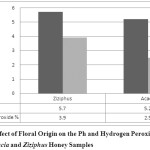 |
Figure 1: Effect of Floral Origin on the Ph and Hydrogen Peroxide in the Acacia and Ziziphus Honey Samples Click here to View figure |
The pH of the Ziziphus honey was significantly more than the pH of the Acacia honey (p- value= 0.005).The hydrogen peroxide percentage in the Ziziphus honey was significantly more than that of the Acacia honey (p- value= 0.007).
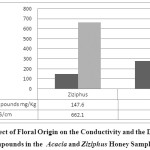 |
Figure 2: Effect of Floral Origin on the Conductivity and the Dicarbonyl Compounds in the Acacia and Ziziphus Honey Samples Click here to View figure |
The Acacia honey conductivity was insignificantly increased compared to its value in the Ziziphus honey (p- value= 0.16). The dicarbonyl compounds concentration in the Acacia honey was significantly more than its concentration in the Ziziphus honey (p- value= 0.04).
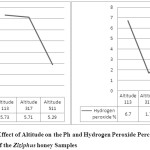 |
Figure 3: Effect of Altitude on the Ph and Hydrogen Peroxide Percentage of the Ziziphus honey Samples Click here to View figure |
Significant pH decrease was reported when the altitude decreased from 113 to 511 meters (p- value= 0.007). The conductivity significantly decreased by the increase of the altitude (p- value≤ 0.000).
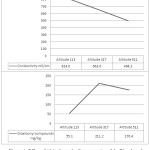 |
Figure 4: Effect of Altitude on the Concentration of the Dicarbonyl Compounds and the Conductivity of the Ziziphus Honey Samples Click here to View figure |
There was significant increase in the dicarbonyl compounds concentration in the Ziziphus honey from the altitude 113 compared to the altitudes of 317 meters (p- value= 0.008) and 511 (p- value= 0.036). the conductivity was decreasing with the increase of the altitude significantly (113 vs 511) and insignificantly (113 vs 317).
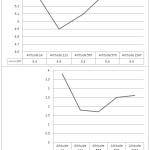 |
Figure 5: Effect of Altitude on the Ph and Hydrogen Peroxide Percentage of the Acacia Honey Samples Click here to View figure |
Significant variations were reported when the conductivity of the 14 meters honey was compared to the honey from the altitudes of 113 and 567 meters. The hydrogen peroxide percentage of the Acacia honey from the altitude 14 was significantly decreased when comparing it to its concentration in the acacia honey from all the other altitudes.
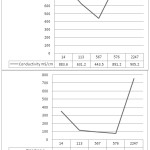 |
Figure 6: Effect of Altitude on the Concentration of Dicarbonyl Compounds and Conductivity of the Acacia Honey Samples |
The concentration of the dicarbonyl compounds in the Acacia honey from the altitude 14 meters was significantly different (decreased and increased) from their concentration in the honey from the other altitudes. The conductivity of the Acacia honey from the 14 meters altitude was significantly different when compared to the honey from the altitude 113 (p- value= 0.01) and 567 (p-value≤ 0.000).
Discussion
The values of the pH of the Acacia and Ziziphus honey samples were within the range of the pH of the reference guide of the USA national honey board (3.4- 6.1).12 This study revealed significant negative and positive effects of altitude on the pH value of the honey samples. However, it is mentioned, in two previous studies, that the altitude positively increased the pH and affected the physio chemical properties of honey samples from Saudi Arabia and Serbia.13,14
This study indicated that the Ziziphus honey was slightly alkaline (5.6) compared to the Acacia honey (5.2). However, our results regarding the Ziziphus honey was comparable to the previous results from Algeria and most of the previous results.15, 16 The mean value of the pH of our Acacia honey was 5.2, this value was higher than most of the previously measured values and it was comparable to honey samples from Lithuania (3.55- 4.88) and Germany (5.4).17- 18
The conductivity of the Acacia honey in our study was 751± 258.3 μS\cm(166- 1200μS\cm), this value was more than most of the previous studies in different countries like Ethiopia (170± 2 μS\cm),19 Romania 156.5(109.9–244.7μS\cm)20 and Hungary (101- 185 μS\cm).21 However, the conductivity of our Acacia honey was comparable to the conductivity of Acacia honey from Malaysia (760 μS\cm).22
The Ziziphus spina christi honey of this study was with a mean value of conductivity of 662.1± 138.2 μS\cm. The conductivity of the Ziziphus spina christi honey was similar to the conductivity of the Ziziphus lotus honey produced in Algeria (654 μS/cm)15 and Ziziphus honey from Moroco (673.42± 150.04 μS/cm).23
Similar to the range of the conductivity of our Ziziphus spina Christi (452- 842 μS/cm), Abdul-Rahman and his colleagues measured the conductivity of Ziziphus spina Christi honey samples from Yemen and found that the range of the conductivity was (439.9- 751.9 μS/cm).24 However, 23 Ziziphus Jujube honey samples from China registered low mean conductivity value compared to our study or to the other previous studies. The mean value of the China Ziziphus Jujube honey was 474 μS/cm.25
Regarding the hydrogen peroxide percentage in the diluted Ziziphus honey (50% w/v) of Asir region, we have achieved a mean value and a range of 3.9± 2.2% (1.22- 6.91%). However, our results were not comparable to most of the previous studies because we used dilution percentage in weight per volume while they used dilution in volume per volume. Generally our conclusion is similar to the conclusion of Al- Shehri26 who found that the hydrogen peroxide concentration in the Ziziphus honey was significantly high than its concentration in the Acacia honey. We compared our results to the results of Chen et al.,27 which they investigated the effect of processing on the hydrogen peroxide concentration in Australian honey and we found that our results were comparable since they obtained a range of hydrogen peroxide between 0- 1017 μM (0- 6.92%) in the unprocessed honey. However, the honey samples of Chen et al.,27 were of different botanical origins rather than the Ziziphus and their dilution was weight per volume as our study. Another comparable previous study findings is that of Juraj et al.,28 who studied the effect of methyl glyoxal (MGO) addition on the production of hydrogen peroxide in Manuka honey and honeydew samples and found that the highest production of hydrogen peroxide was obtained in the 50% (w/v) dilution of the honeydew samples. The highest hydrogen peroxide concentration range of the Juraj study was (306.9- 495.8 μM) (2.09- 3.37% w/w).28 However, Eman Halawani and Mohamed Shohayeb analyzed different Ziziphus honey samples from Saudi Arabia, Yemen, Pakistan and Turkey and their hydrogen peroxide percentages were 8.3%, 6.8%, 8.6% and 7.5% respectively.29
Similar to Al- Shehri,26 we found that the hydrogen peroxide percentage in the Acacia honey was less than its percentage in the Ziziphus honey. The mean hydrogen peroxide percentage in the Acacia honey was 2.5% ± 0.83. Our result was less than the results of another Saudi honey study which registered 4.8% for German honey.29
Concerning the concentration of the dicarbonyl molecules in the Acacia and Ziziphus honey samples from Asir region, we have reported significantly high concentration in the Acacia honey (49.3- 928 mg/Kg) compared to the Ziziphus honey (5.8- 263.9 mg/ Kg). Our results were comparable to the majority of the previous studies like the study of Marshal30 who reported a total carbonyl compounds concentration in monofloral honey samples range of (212- 3679 μg/g). Another study measured the concentration of 3 deoxyglucosone, glyoxal and methyl glyoxal in different honey samples and registered their concentration ranges as follows: (75.9 – 808.6 mg/kg), (0.1-10.9 mg/kg) and (0.2-2.9 mg/kg), respectively.31
Our results showed that there was an inverse relationship between the hydrogen peroxide percentage and the concentration of the dicarbonyl compounds in the honey samples, this results was similar to the finding of Juraj28 who stated that addition of methylglyoxal to honey samples leaded to the reduction of the hydrogen peroxide percentage.28
With regard to effect of altitude on the percentage of hydrogen peroxide and dicarbonyle molecules in the honey, no previous study was found. There are two published papers associated with the effect of altitude on the physiochemical properties of honey and they reported a significant positive and negative effects on the studied physiochemical characteristics.13, 14
Conclusions
The Ziziphus honey of Asir region was characterized by significantly high percentage of hydrogen peroxide compared to the Acacia honey while the Acacia honey was associated with significantly increased concentration of the dicarbonyl compounds compared to the Ziziphus honey.
The altitude significantly increased the dicarbonyle molecules concentration and significantly decreased the hydrogen peroxide percentage irrespective of their floral origin.
Acknowledgments
This research was financially supported by King Abdulaziz City for Science and Technology through grant number (1-17-01-010-0006).
Conflict of Interest
All the authors have declared no conflict of interest.
References
- Codex Alimentarius. 1981. Standards for honey. CODEX STAN 12-1981 revised 2001.
- Bogdanov Honey as Nutrient and Functional Food: A Review. Bee Product Science. 2015: 1-47.
- TOMÁS-BARBERÁN A., MARTOS I., FERRERES F., RADOVIC B. S., ANKLAM E. HPLC. flavonoid profiles as markers for the botanical origin of European unifloral honeys. Journal of the Science of Food and Agriculture. 2001; 81 (5): 485-496.
CrossRef - Da Silva P.M., Cony G, Luciano V. G., Ana C. O. C., Roseane F. Honey: Chemical composition, stability and authenticity. Food Chemistry. 2016;196:309–323. http://dx.doi.org/10.1016/j.foodchem.2015.09.051.
CrossRef - El Sohaimy S. A., Masry S. H. D., Shehata M. G. Physicochemical characteristics of honey from different origins. Agric. Sci. (2015). http://dx.doi.org/10.1016/j.aoas.2015.10.01.
- Jarvis A., Reuter H.1, Nelson A., Guevara E. Hole-filled SRTM for the globe Version 4. 2008. Available from the CGIAR-CSI SRTM 90m Database (http://srtm.csi.cgiar.org).
- Louveaux J., Maurizio A., Vorwohl G. International Commission for bee botany of IUBS. Methods of Melissopalynology. Bee Word. 1978;59(4): 139- 157.
CrossRef - International Honey Commission. pH and free acidity in the Harmonized methods of the International Honey Commission. 2009: 21- 23.
- International Honey Commission. Determination of electrical conductivity in the Harmonized methods of the International Honey Commission. 2009: 16- 18.
- USP Technologies. Ceric sulfate titration. Available at: http://www.h2o2.com/technical-library/analytical- methods/default.aspx?pid=69&name=Ceric-Sulfate-Titration. Accessed on 7.4. 2018 at 12:29.
- Kwok H., Kirkpatrick G., Mohd Y. H. I., Portokalakis I., Nigam P. S., Owusu-Apenten R. Rapid Colorimetric Determination of Methylglyoxal Equivalents for Manuka Honey. Journal of Advances in Biology & Biotechnology. 2016; 7(1): 1-6. DOI: 10.9734/JABB/2016/26592.
CrossRef - National Honey Board. Honey a reference guide to nature’s sweetener. Firestone, CO, USA. 2005.
- JOVANKA P., NEBOJŠA A., BRANISLAV Z., BILJANA B., MIĆA M., JOVANKA L., MILAN IVKOV., VLADIMIR P. Evaluation of color, mineral substances and sensory uniqueness of meadow and acacia honey from Serbia. Romanian Biotechnological Letters. 2015; 20(5): 10784- 10799.
- Mohammed E. A. M., Abdallah A., Abdalaziz A., Mohammad Y. A., Serag Eldin I. E., Helmey A. A. Some Physiochemical Properties of Acacia Honey from Different Altitudes of the Asir Region in Southern Saudi Arabia. Czech J. Food Sci. 2017; 35(4): 321–327. doi: 10.17221/428/2016-CJFS.
CrossRef - Salim Z., María C. S., Olga E., María S. R. Characterization of the Ziziphus lotus (jujube) honey produced in Algeria. Journal of Apicultural Research. 2017; 57(1): 166- 174. DOI: 10.1080/00218839.2017.1399663.
CrossRef - Al-Kalifa A. S and Al-Arify I. A. Physiochemical characteristics and pollen spectrum of some Saudi honeys. Food Chemistry. 1999; 67: 21- 25. DOI: 10.1016/S0308-8146(99)00096-5.
CrossRef - Kowalski S., Lukasiewicz M., Berski W. Applicability of physio-chemical parameters of honey for identification of the botanical origin. Sci.Pol.Technol.Aliment. 2013; 12: 51- 59.
- Alzahrani A., Alsabehi R., Boukraâ L., Abdellah F., Bellik Y., Bakhoutmah B. A. Antibacterial and antioxidant potency of floral honeys from different botanical and geographical origins. Molecules. 2012; 17: 10540- 10549.
CrossRef - Gangwar K., Gebremariam H., Ebrahim A., Tajebe S. Characteristics of honey produced by different plant species in Ethiopia. Advances in Bioresearch. 2010;1(1):101-105.
- Mircea O and Ropciuc S. Honey authentication based on physicochemical parameters and phenolic compounds. Computers and Electronics in Agriculture 2017;138:148–156. DOI: 10.1016/j.compag.2017.04.020.
CrossRef - Czipa N and Kovâcs B. Electrical conductivity of hungarian honeys. Food Physics. 2014;27:13-20.
- Moniruzzaman M., Ibrahim K., Siti Amrah S., Siew H. G. Physicochemical and antioxidant properties of Malaysian honeys produced by Apis cerana., Apis dorsata and Apis mellifera. BMC Complementary and Alternative Medicine. 2013;13:43.
CrossRef - Amina C., Abder Rahmane R., Gian L. M, Paola F. Physicochemical properties of some honeys produced from different plants in Morocco. Arabian Journal of Chemistry. 2016; 9:S946–S954. DOI:10.1016/j.arabjc.2011.10.013.
CrossRef - Abdul-Rahman A., Haidy A. G., Sherweit H. E., Mohamed I. A., Mohamed S. K., Mohamed M. A. Characterization and Discrimination of the Floral Origin of Sidr Honey by Physicochemical Data Combined with Multivariate Analysis. Food Anal. Methods. 2017;10:137–146. DOI: 10.1007/s12161-016-0563-x.
CrossRef - Juan Z., Zhirong S., Pinpin Z., Ni C., Hui G., Jing Z., Wei C. Jujube Honey from China: Physicochemical Characteristics and Mineral Contents. Journal of Food Science. 2013;78(3):C387-C394. DOI: 10.1111/1750-3841.12049.
CrossRef - Al- Shehri. The antibacterial hydrogen peroxide generation from Ziziphus Spina Christi and Acacia spp. Honey. Academia Journal of Scientific Research. 2017; 5(9): 290-296. DOI: 10.15413/ajsr.2017.0135.
CrossRef - Chen C., Leona T. C., Shona E. B., Dee A. C. The effect of standard heat and filtration processing procedures on antimicrobial activity and hydrogen peroxide levels in honey. Frontiers in Microbiology. 2012; 3: 265. doi: 10.3389/fmicb.2012.00265.
CrossRef - Juraj M., Jana B., Emanuel P., Jaroslav K. Methylglyoxal May Affect Hydrogen Peroxide Accumulation in Manuka Honey Through the Inhibition of Glucose Oxidase. J Med Food. 2014; 17 (2): 290–293. DOI: 10.1089/jmf.2012.0201.
CrossRef - Eman H and Mohamed S. Survey of the antibacterial activity of Saudi and some international honeys. Journal of Microbiology and Antimicrobials. 2011; 3(4): 94-101.
- Sarah M. M. Identification and concentration of phenolic and carbonyl compounds in Florida honeys. Master of Science thesis. University of Florida. 2013.
- Arena E., Ballistreri G., Tomaselli F., Fallico B. Survey of 1,2-dicarbonyl compounds in commercial honey of different floral origin. J Food Sci. 2011; 76(8): C1203-10. doi: 10.1111/j.1750-3841.2011.02352.x.
CrossRef

This work is licensed under a Creative Commons Attribution 4.0 International License.






